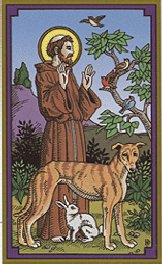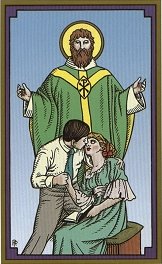The allocation of a fortune-telling aspect to these cards is the story of a prolonged impertinence.
-- A.E. Waite
How do I use a Tarot deck to tell the future?
Oh come now, if people could use Tarot cards to tell the future, they'd be doing it. And if they'd be doing it, they'd be running the world, not telling you about it.
-- Tarot FAQ (from JK's tarot site, unfortunately now down)
There are many methods for predicting the future. For example, you can read horoscopes, tea leaves, tarot cards, or crystal balls. Collectively, these methods are known as "nutty methods." Or you can put well-researched facts into sophisticated computer models, more commonly referred to as "a complete waste of time."
-- Scott Adams
The familiar Tarot deck
was of course originally used for playing card games.
Card and board games have always challenged (and perhaps developed)
the mind, as athletics builds the body.
Of course the deck is a work of art based on interfaith symbols,
and it has no supernatural powers. Click here
for Christian artwork and symbols on a tarot decks.
I got the rules from A.E. Waite's description of the ancestral
game "Tarokay" in
A Pictorial Key to the Tarot.
Of course, the "Waite-Rider deck", used here, was drawn by Pamela Coleman
Smith under Waite's supervision.
There are many variants of Tarot games. (In the United States, most
card games are played with the poker deck instead.)
I interpreted Waite's article
in light of other Tarot games.
You, the human player, begin as dealer.
We imagine that you deal twenty-four cards to each of the three players,
beginning with the player
at your right, and continuing counter-clockwise.
The six cards left over are the widow ("kitty", etc.) When you are
dealer, the program assumes that you want to
pick them
up and discard six cards of your own.
Before play starts, each player declares
their melds.
In the play for tricks,
the second hand leads. The "Major Arcana" are always
trumps. Play goes counter-clockwise. You must follow suit if you can,
and if you cannot, you must play a trump.
However, if you have The Fool you may play it instead of following suit or trumping.
If you lead the Fool at the beginning of a trick, the next player can play any card.
The second card played to that trick defines the "suit led" for the trick.
The Fool cannot win a trick.
Waite explains, "The highest card of the suit led takes the trick, unless it is trumped.
In that case the highest trump takes it.
The trumps rank from XXI high down to I low.
The masculine suits of Swords and Staves rank from King high down to Ace low.
The feminine suits of Cups and Pentacles (Coins) rank the same as the masculine from
King down to Page, but from there on the order is reversed: Ace is highest, then two, and so on down to ten.
The second-highest score is subtracted from the high score for each round. Say that Player 3 has the highest score: 74. Subtract from this the next highest, 51, and the actual score for that hand is 23 points for Player 3. The game coutinues in thls way until a player wins the game with a score of 100 points.
"Scoring Melds and Tricks:
The five Greater Trumps (XVII - XXI, the cards that present the triumph of Eternity): count 5 points for three of these, 10 points for four, 15 points if player has all five.
The five Lesser Trumps (I - V, the cards that represent the captives of Cupid): count the same as the Greater Trumps.
The seven 'Tarot Trumps' (I, XXI, The Fool, and the Kings of the four suits): count 15 points for every three of these.
Sequences in the same suit, including the Trump suit:
Count 5 for any four-card sequence,
10 for any seven-card sequence,
15 for any ten-card sequence."
In scoring cards taken in tricks, I followed the usual way
counting
card points in tarot games.
Count 1 point for each trick taken.
Add 4 for each Tarot Trump except the Fool (following Waite),
3 for each queen, 2 for each knight, and 1 for each page.
It seems most reasonable to me to think that the Tarot began as playing cards, for entertainment and games, when sufficiently sturdy paper / pasteboard was invented. The suit cards are like our own playing cards.
The trumps present common interfaith symbols that people from many traditions have found helpful in reflection and meditation.
My own experience has been that this can perhaps improve your life if (and only if) your intention is to stop focusing on life's "small stuff" and prepare you to be kind to those around you.
If there are really any intricate cosmic secrets here, I have
been unable to understand them.
Call me dumb or unspiritual if you like.
When I have actually seen the cards used for divination by practitioners,
they were obviously being used as mere props for lay-counselling.
Kings would rank highest, then queens.
Chivalric knights were sworn to serve queens, and pages were squires
to knights. In the trump suit, notice how often a card seems naturally
to take precedence over the one just below it. No reasonable person would deny that the cards are beautiful and meaningful, or claim that this is just a more complex version of "scissors, paper, stone".
* If, as in the old decks, the tower is the "House of God", then the Church defeats
the devil, and nothing below the heavens can take precedence over the Church.
As a kid, I spent quite a bit of time
with Waite's book and the tarot pack. I wondered about his hints
that he possessed
great secret knowledge. (Re-read his description of the "Hanged Man",
look closely at the Ace of Cups,
recall that in his own life he professed the Christian faith,
and then draw your own conclusions.) Today I appreciate him most as the first person
to write systematically about the western occult tradition.
At least some of his Golden Dawn fellow-seekers of "secret knowledge" eventually
found the Ignatian "Spiritual Exercises" more helpful.
There are more elaborate games than the one I've shared here. In most, a greater skill element comes from bidding
various contracts prior to play for tricks.
Tarot Game Rules -- links to more complicated games with bidding
Danish Tarot



The "Latin" suits may represent the military and government (swords),
the clergy (cups),
the business folks (coins),
and the laborers (staves).

The Magician ("juggler", "mountebank" or "sleight of hand artist") may have been introduced first, as a wild card like
our joker for some card games.

The High Priestess was a female pope ("la Papesse"). When it was decided
to introduce a second wild card, a female trickster might have been chosen as the
magician's counterpart. The legend of "Pope Joan" may have attached
itself to the card.

The next three cards may have been introduced together. The Empress would have precedence over the previous two cards, and the four Kings.

The Emperor, of course, is lord over the Empress. The Holy Roman Empire was in existence when the cards were developed.

The Hierophant is probably the Pope, to whom the Emperor owed obedience, at least in theory.

Romantic love has power over every human being. Waite called the first five cards "the captives of Cupid."

War interrupts the lives of Lovers and can take love even out of the human heart.
I've been told that the bonds between comrades-in-arms are stronger than between Lovers.

Strength ("fortitude") gives victory over the enemy Chariots. Socrates's four temporal virtues (fortitude, justice, temperance, and perhaps wisdom / judgement) may all be represented in the images.

The Hermit may originally have been Father Time, who wears down all Strength.

The Wheel of Fortune, or the cycle of Luck, operates through all Time and over the years.

Justice, rather than Luck, should determine what happens to a person.

The Hanged Man is a mystery. Perhaps this is an extrajudicial lynching.
Perhaps this is a cryptic representation of the One Who fulfilled the demands of the law's Justice by His death.

Everything represented up to now is subject to human mortality.

Temperance, living a wholesome life, gives the best chance of staying
healthy and avoiding premature Death.

The devil tempts us to live in ways that are not temperate or otherwise wholesome.

At the destruction of the Tower of Babel, the devil's agents were dramatically defeated. *

The Star shines high above all Towers.

The Moon outshines the Stars.

The Sun outshines the Moon.

At the Last Judgement, the Sun and all rest of creation will disappear.

A card representing a Fool (simpleton) was probably introduced to be playable at any time.

The World contains all the things that can possibly be, and
so it is the highest of all cards. Perhaps this is the
new World that will follow the Last Judgement.
Tarot History
Various Tarot Decks
Tarocchino -- downloadable book of tarot games. No-nonsense account of the history of the gaming cards and the bunko artists who made it an "occult mystery." Thanks!
The Castle of Crossed Destinies -- "semiotic fantasy novel"

Francis of Assisi
Christian Tarot Decks
Tarot and Evangelism -- prof at U. of Aberdeen divinity school. Like any evangelist, meeting "New Agers" where they already are.
Tarot of the Saints -- Biblical and historical images, some gnosticizing
Tarot of the Saints -- Amazon
Tarot of the Saints -- Margaret of Rome resists the devil, etc.

VI. The Lovers
French Tarot for Three
French Tarot for Four
German Cego
Hungarian Tarot
Konigrufen -- complicated, casual tarot game
Swiss Troccas
Scarto -- primitive tarot game
Bid Tarot -- primitive tarot game with bidding
Meet Ed